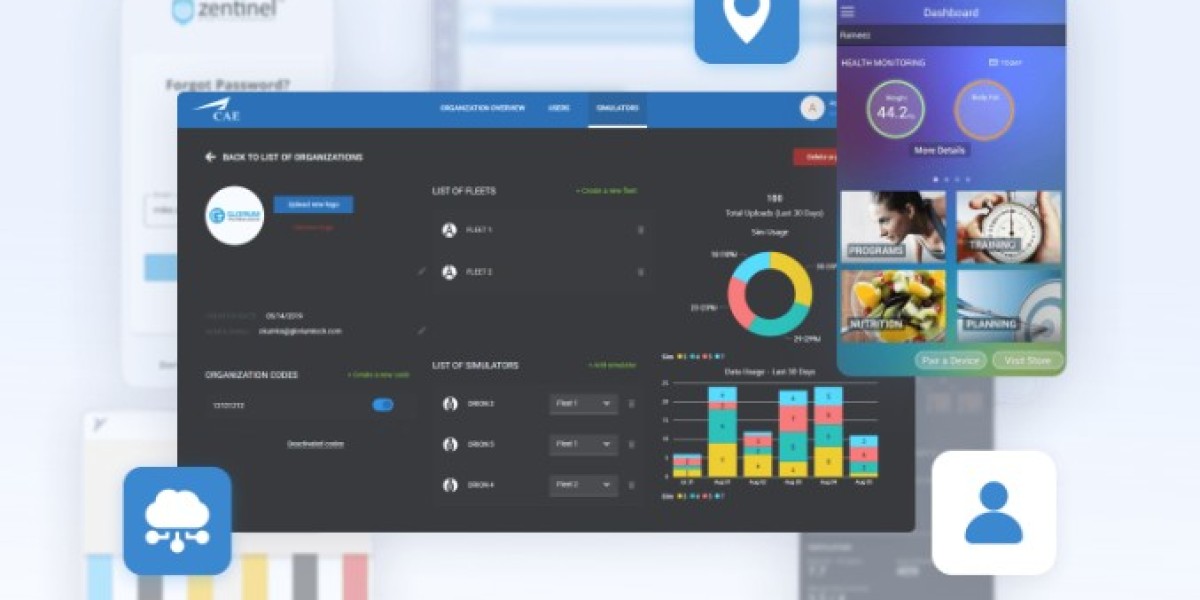Central to this evolution is the advent of remote patient monitoring software development, which plays a pivotal role in expanding and enhancing telehealth services. This article explores how RPM software is reshaping telehealth, its benefits, challenges, and future prospects.
1. Introduction to Remote Patient Monitoring (RPM)
Remote Patient Monitoring (RPM) involves the use of technology to monitor patients' health data from a distance. RPM systems collect data on various health metrics, such as blood pressure, glucose levels, heart rate, and weight, and transmit this information to healthcare providers. This allows for continuous monitoring of patients' conditions without the need for in-person visits.
RPM is a cornerstone of telehealth, which broadly encompasses the use of technology to provide healthcare services remotely. Telehealth includes telemedicine, which involves clinical services, and telecare, which encompasses broader healthcare activities, including patient education and management.
2. How RPM Enhances Telehealth Services
2.1 Improved Patient Monitoring and Management
RPM software allows healthcare providers to track patients' vital signs and health metrics in real-time. This continuous monitoring helps in identifying potential issues early and enables timely intervention. For chronic conditions like diabetes, hypertension, or heart disease, RPM can provide crucial data that helps in managing these conditions more effectively.
For example, a patient with diabetes can use a glucose monitoring device connected to RPM software. The system tracks blood sugar levels throughout the day and alerts the healthcare provider if levels are out of the expected range. This proactive approach helps prevent complications and hospitalizations.
2.2 Enhanced Patient Engagement
RPM software often includes features that engage patients in their own care. Many RPM systems come with user-friendly interfaces that allow patients to view their health data, understand trends, and receive educational content about managing their condition.
When patients are more engaged and informed about their health, they are more likely to adhere to treatment plans and make lifestyle changes that improve their overall health. RPM systems often provide feedback and reminders, encouraging patients to take their medications, follow dietary recommendations, or exercise regularly.
2.3 Reduced Healthcare Costs
By reducing the need for frequent in-person visits, RPM can lower healthcare costs for both patients and providers. Telehealth visits and remote monitoring are generally less expensive than traditional face-to-face consultations. RPM helps in reducing hospital readmissions, emergency room visits, and unnecessary office visits by providing continuous monitoring and early detection of potential issues.
For instance, a study by the American Journal of Managed Care found that RPM for patients with chronic conditions reduced hospitalizations by 40% and emergency room visits by 50%, translating to significant cost savings for healthcare systems.
2.4 Access to Care in Remote Areas
RPM expands access to healthcare services, especially in rural and underserved areas where healthcare resources may be limited. Patients in these areas often face challenges in accessing specialized care due to geographical barriers. RPM software allows patients to receive high-quality care without the need for long-distance travel.
For example, a patient living in a remote village can use RPM devices to monitor their heart condition and transmit data to a cardiologist in a major city. This connectivity bridges the gap between patients and specialists, ensuring timely and effective care.
3. Key Features of Effective RPM Software
To maximize the benefits of RPM, the software should possess several key features:
3.1 Integration with Electronic Health Records (EHRs)
Effective RPM software should seamlessly integrate with EHR systems. This integration allows for automatic data synchronization, reducing the risk of errors and ensuring that patient information is up-to-date and accessible to all relevant healthcare providers.
3.2 Real-Time Data Transmission
Real-time data transmission is crucial for effective remote monitoring. RPM software should be able to collect and transmit health data instantly to healthcare providers, allowing for timely interventions and adjustments to treatment plans.
3.3 User-Friendly Interfaces
Both patients and healthcare providers should find RPM software easy to use. Patient-facing interfaces should be intuitive, with clear instructions and visualizations of health data. For healthcare providers, the interface should offer customizable dashboards, data analytics, and easy access to patient information.
3.4 Security and Compliance
Given the sensitive nature of health data, RPM software must adhere to strict security and privacy standards. Compliance with regulations such as the Health Insurance Portability and Accountability Act (HIPAA) in the United States is essential to ensure the confidentiality and security of patient information.
4. Challenges and Considerations in Implementing RPM
Despite its benefits, implementing RPM software comes with challenges:
4.1 Technological Barriers
Not all patients have access to the necessary technology or reliable internet connections for RPM. Addressing these barriers is crucial to ensure equitable access to remote monitoring services.
4.2 Data Security and Privacy Concerns
The collection and transmission of health data raise concerns about data security and privacy. Healthcare providers must ensure that RPM systems comply with regulations and implement robust security measures to protect patient information.
4.3 Integration with Existing Systems
Integrating RPM software with existing healthcare systems, such as EHRs and practice management systems, can be complex. Ensuring seamless integration is essential to avoid data silos and ensure a cohesive healthcare experience for patients.
4.4 Patient and Provider Training
Both patients and healthcare providers need training to use RPM systems effectively. Ensuring that users are comfortable with the technology and understand how to interpret and act on health data is crucial for successful implementation.
5. Future Trends in RPM and Telehealth
As technology continues to advance, RPM and telehealth are expected to evolve significantly:
5.1 Artificial Intelligence and Machine Learning
Artificial Intelligence (AI) and Machine Learning (ML) are poised to play a major role in RPM. AI algorithms can analyze vast amounts of health data to identify patterns, predict health issues, and provide personalized recommendations. For example, AI-powered RPM systems could offer predictive analytics for managing chronic conditions, allowing for more precise and proactive care.
5.2 Integration with Wearable Technology
Wearable technology, such as smartwatches and fitness trackers, is becoming increasingly sophisticated. Integrating these devices with RPM systems can provide a more comprehensive view of a patient's health. Wearables can track various metrics, including physical activity, sleep patterns, and stress levels, offering valuable insights for managing overall health.
5.3 Expansion of Telehealth Services
The expansion of telehealth services is likely to continue, driven by advances in RPM technology. Future developments may include more advanced remote diagnostic tools, virtual reality for remote consultations, and enhanced patient-provider communication platforms.
6. Conclusion
Remote Patient Monitoring software is a crucial component of modern telehealth services, offering numerous benefits including improved patient management, enhanced engagement, cost savings, and expanded access to care. Despite challenges such as technological barriers and data security concerns, the potential of RPM to transform healthcare is significant.
As technology continues to advance, the role of RPM in telehealth is expected to grow, bringing new opportunities for improving patient care and health outcomes. By embracing these innovations and addressing the challenges, healthcare providers can leverage RPM to enhance the quality and accessibility of care in the evolving landscape of telehealth.













